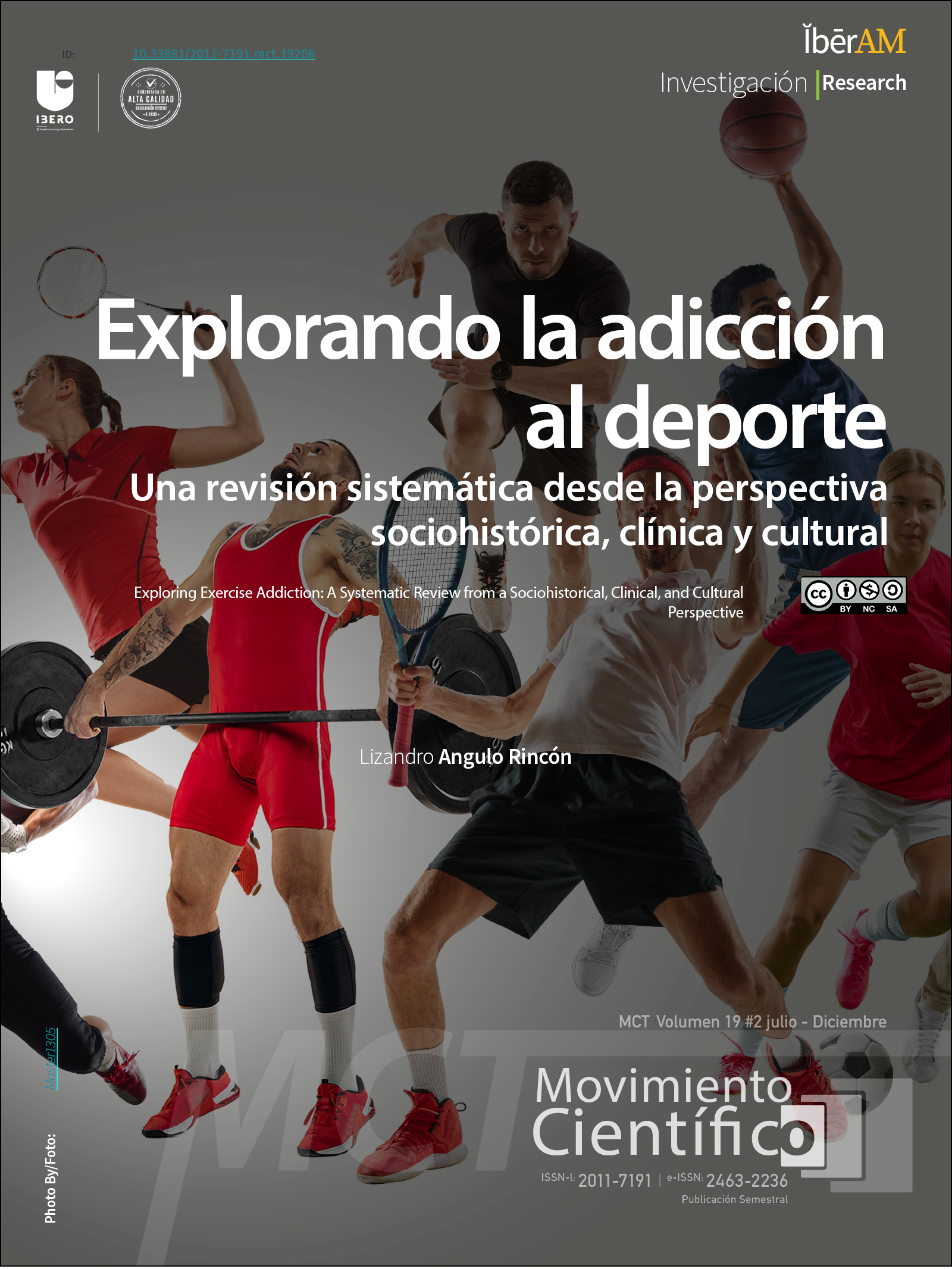Explorando la adicción del deporte
Exploring Sports Addiction Una revisión sistemática desde la perspectiva sociohistórica, clínica y cultural
Contenido principal del artículo
La adicción al deporte es un trastorno del comportamiento en el que el sujeto exhibe dependencia al ejercicio, a pesar del dolor, la fatiga y las lesiones, entre otras manifestaciones. Esta investigación tiene como objetivo explorar y sintetizar de manera sistemática la literatura científica sobre la adicción al deporte desde una perspectiva sociohistórica, clínica y cultural, enfocándose en su etiología, diagnóstico y prevalencia. Se emplea un enfoque cualitativo, con carácter exploratorio, para examinar la bibliografía especializada con los métodos de la investigación documental y su variante la investigación documental digital. Los resultados y conclusiones sugieren que, de acuerdo con los estudios actuales y a pesar de la presencia de otras enfermedades que la pueden detonar, la adicción al deporte requiere una atención especializada para aminorar sus síntomas y preparar al deportista a enfrentar las consecuencias en su salud física y mental.
Descargas
Datos de publicación
Perfil evaluadores/as N/D
Declaraciones de autoría
Indexado en
-
—
- Sociedad académica
- N/D
- Editorial
- Bogotá: Corporación Universitaria Iberoamericana
Detalles del artículo
Alonso Andrade, J., García, S., Remicio, C., & Villamil Buitrago, S. (2012). Niveles de adicción al ejercicio corporal en personas fisicoculturistas. Revista Iberoamericana de Psicología del Ejercicio y el Deporte, 7(2), 209-226.
Berczik, K., Szabó, A., Griffiths, M. D., Kurimay, T., Kun, B., Urbán, R., & Demetrovics, Z. (2012a). Exercise addiction: Symptoms, diagnosis, epidemiology, and etiology. Substance Use and Misuse, 47(4), 403-417. https://doi.org/10.3109/10826084.2011.639120
Berczik, K., Szabó, A., Griffiths, M. D., Kurimay, T., Kun, B., Urbán, R., & Demetrovics, Z. (2012b). Exercise addiction: Symptoms, diagnosis, epidemiology, and etiology. Substance Use and Misuse, 47(4), 403-417. https://doi.org/10.3109/10826084.2011.639120
Berryman, J. W. (1989). The tradition of “six things natural”: Exercise and medicine from Hippocrates to ante-bellum America. 17(1), 515-560. https://journals.lww.com/acsm-essr/citation/1989/00170/The_Tradition_of_the__Six_Things_Non_Natural__.17.aspx
Berryman, J. W. (2010). Exercise is Medicine: A Historical Perspective. Curr. Sports Med. Rep, 9(4), 195-201. https://doi.org/10.1249/JSR.0b013e3181e7d86d
Best, R., & Howard, D. (2022). The Global Sports Industry: Events, Fans, Products, Participans & COVID-19 Impact. Global Sports Insights.
Dietrich, A., & McDaniel, W. F. (2004). Endocannabinoids and exercise. British Journal of Sports Medicine, 38, 536-541. https://bjsm.bmj.com/content/38/5/536.info
Favier-Ambrosini, B. (2016). Socio-histoire du lien entre activité physique et santé de 1960 à 1980. 1, 13-24. https://shs.cairn.info/article/SPUB_160_0013
Galvão, T. F., Tiguman, G. M. B., & Sarkis-Onofre, R. (2022). A declaração PRISMA 2020 em português: recomendações atualizadas para o relato de revisões sistemáticas. Epidemiologia e Serviços de Saúde, 31(2), e2022364. https://doi.org/10.1590/SS2237-9622202200011
Gauld, C., Francou, C., Millet, G. Y., Kern, L., & Gergelé, L. (2024). A symptom network analysis of exercise addiction and personality on ultra-marathon runners with serious complications. International Journal of Sport and Exercise Psychology, 22(7), 1625-1639. https://doi.org/10.1080/1612197X.2023.2204878
Glasser, W. (1976). Positive addiction (Vol. 11). Harper & Row.
Godoy-Izquierdo, D., Navarrón, E., López-Mora, C., & González-Hernández, J. (2023). Exercise Addiction in the Sports Context: What Is Known and What Is Yet to Be Known. International Journal of Mental Health and Addiction, 21(2), 1057-1074. https://doi.org/10.1007/s11469-021-00641-9
Hacking, I. (2000). The Social Construction of What? Harvard University Press.
Hamer, M., & Karageorghis, C. I. (2007). Psychobiological Mechanisms of Exercise Dependence. Sports Medicine, 37(6), 477-484. https://doi.org/10.2165/00007256-200737060-00002
Hausenblas, H. A., & Downs, D. S. (2002). How much is too much? The development and validation of the exercise dependence scale. Psychology and Health, 17(4), 387-404. https://doi.org/10.1080/0887044022000004894
Hernández, R., Fernández, C., & Baptista, P. (2014). Metodología de la investigación (6a. Edició). McGraw Hill. https://doi.org/10.1192/bjp.112.483.211-a
Keane, H. (2021). A normalised future of addiction. International Journal of Drug Policy, 94, 102972. https://doi.org/10.1016/J.DRUGPO.2020.102972
Kelly, N. (2019, diciembre 7). Adicción al ejercicio: cómo el deporte puede convertirse en una obsesión poco saludable -. BBC News Mundo. https://www.bbc.com/mundo/noticias-50699226
Knapp, S., Miller, A., Outar, L., & Turner, M. (2023). Psychological well-being and exercise addiction: The treatment effects of an REBT intervention for females. Psychology of Sport and Exercise, 64. https://doi.org/10.1016/j.psychsport.2022.102298
Lantz, C. D., Rhea, D. J., Cornelius, A. E., Lantz, C. D., Rhea, D. J., & Cor, A. E. (2002). Muscle Dysmorphia in Elite-Level Power Lifters and Bodybuilders: A Test of Differences Within a Conceptual Model. National Strength & Conditioning Association J. Strength Cond. Res, 16(4), 649-655. https://journals.lww.com/nsca-jscr/abstract/2002/11000/muscle_dysmorphia_in_elite_level_power_lifters_and.26.aspx
Larocque, E., & Moreau, N. (2023). When sport is taken to extremes: A sociohistorical analysis of sport addiction. International Review for the Sociology of Sport, 58(2), 368-391. https://doi.org/10.1177/10126902221104956
Lejoyeux, M., Avril, M., Richoux, C., Embouazza, H., & Nivoli, F. (2008). Prevalence of exercise dependence and other behavioral addictions among clients of a Parisian fitness room. Comprehensive Psychiatry, 49(4), 353-358. https://doi.org/10.1016/J.COMPPSYCH.2007.12.005
Lichtenstein, M. B., Emborg, B., Hemmingsen, S. D., & Hansen, N. B. (2017). Is exercise addiction in fitness centers a socially accepted behavior? Addictive Behaviors Reports, 6, 102-105. https://doi.org/10.1016/j.abrep.2017.09.002
Lima, D. (2023). Dependência de exercício físico: uma revisão sistemática da literatura.
Márquez, S., & de la Vega, R. (2015). La adicción al ejercicio: Un trastorno emergente de la conducta. Nutricion Hospitalaria, 31(6), 2384-2391. https://doi.org/10.3305/nh.2015.31.6.8934
Márquez, S., & Molinero, O. (2013). Disponibilidad De energía, disfunción menstrual y salud ósea en el deporte; una revisión de la tríada de la atleta femenina. En Nutricion Hospitalaria (Vol. 28, Número 4, pp. 1010-1017). https://doi.org/10.3305/nh.2013.28.4.6542
Morgan, W. P. (1979). Negative Addiction in Runners. The Physician and Sportsmedicine, 7(2), 55-77.
National Institute on Drug Abuse. (2024, enero). Esteroides anabólicos y otras drogas para mejorar la apariencia y el rendimiento. https://nida.nih.gov/es/areas-de-investigacion/esteroides-anabolicos-y-otras-drogas-para-mejorar-la-apariencia-y-el-rendimiento-apeds?utm_source=chatgpt.com
Oehlhof, M. E. W., Musher-Eizenman, D. R., Neufeld, J. M., & Hauser, J. C. (2009). Self-objectification and ideal body shape for men and women. Body Image, 6(4), 308-310. https://doi.org/10.1016/J.BODYIM.2009.05.002
Omar, A. N. M., El Hamady, M. M., El Bakry, S. T., Samy, P. V., & Abd-Elmaksoud, S. F. (2023). A study of relation between sports addiction, Internet use, and video gaming among a sample of Egyptian sports clubs’ attendants. Middle East Current Psychiatry, 30(1), 1-11. https://doi.org/10.1186/s43045-023-00284-7
Organización Mundial de la Salud. (2022). Informe sobre la situación mundial de la actividad física 2022. https://www.who.int/es/publications/i/item/9789240060449
Ramos, J., Sansebastián, J. A., & Gurpide, A. (2001). Desarrollo, validez y seguridad de una escala de adicción general. Un estudio preliminar. Actas Esp Psiquiatr, 29(6), 368-373.
Rodríguez, J. M. (2007). Vigorexia, adicción, obsesión o dismorfia; un intento de aproximación. Salud y Drogas, 7(2), 289-308. http://www.redalyc.org/articulo.oa?id=83970205
Schutt, R. (2019). Investigating the social world. The process and Practice of Research. En Kemampuan Koneksi Matematis (Tinjauan Terhadap Pendekatan Pembelajaran Savi) (Vol. 53, Número 9).
Smith, D., Wright, C., & Winrow, D. (2010). Exercise dependence and social physique anxiety in competitive and non-competitive runners. International Journal of Sport and Exercise Psychology, 8(1), 61-69. https://doi.org/10.1080/1612197X.2010.9671934
Thege, B. K., Woodin, E. M., Hodgins, D. C., & Williams, R. J. (2015). Natural course of behavioral addictions: A 5-year longitudinal study. BMC Psychiatry, 15(1). https://doi.org/10.1186/s12888-015-0383-3
Tipton, C. M. (2014). Historical Perspectives The history of «Exercise Is Medicine» in ancient civilizations. Adv Physiol Educ, 38, 109-117. https://doi.org/10.1152/advan.00136.2013.-In
Veale, D. (1995). Does primary exercise dependence really exist? En C. B. Annet J & Steinberg H. (Eds.), Exercise addiction: motivation for participation in sport and exercise. The British Psychological Society.
Vicentini de Oliveira, D., Freire, G. L. M., Bortolussi, I., Oliveira, R. V., & Nascimento Júnior, J. R. A. (2022). Autoestima e Dependência de Exercício em Praticantes de Musculação. Revista Psicologia e Saúde, 4, 171-182. https://doi.org/10.20435/pssa.v13i4.1201
Weinstein, A., & Weinstein, Y. (2014). Exercise Addiction- Diagnosis, Bio-Psychological Mechanisms and Treatment Issues. Current Pharmaceutical Design, 20(25), 4062-4069.
Zhang, C. (2014). What can we learn from the history of male anorexia nervosa? En Journal of Eating Disorders (Vol. 2, Número 1). BioMed Central Ltd. https://doi.org/10.1186/s40337-014-0036-9
Citaciones
Datos de los fondos
-
Universidad del Tolima
Números de la subvención 110123














